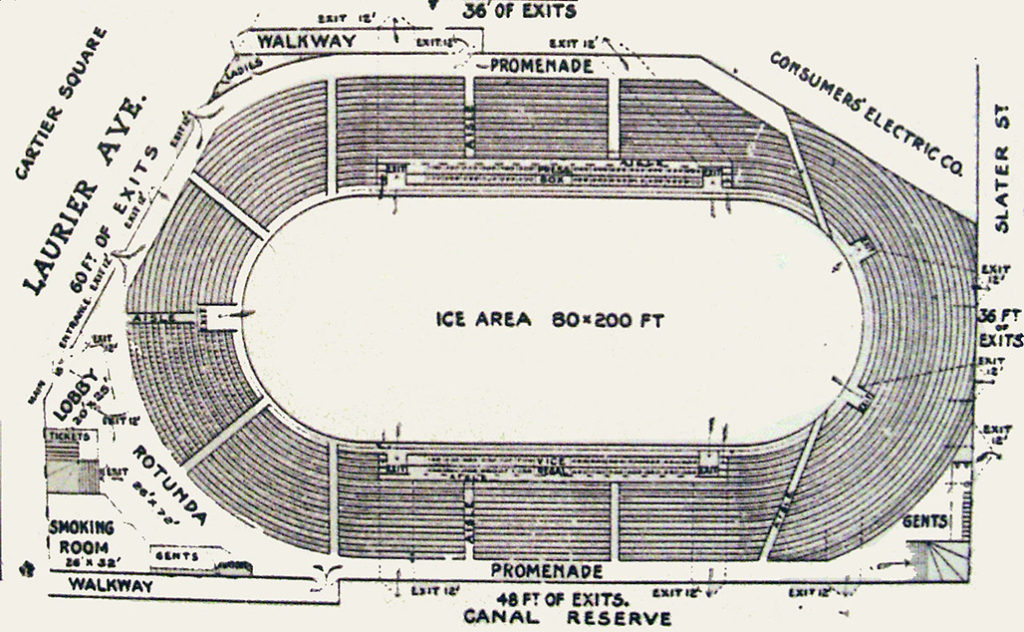The NHL is in the midst of a 100th-anniversary celebration, with the first official league season occurring in 1917-1918. We look back at the facilities that hosted the four NHL teams in that inaugural season.
The NHL was barely a league in 1917-1918, with only three teams lasting the entire season: the Montreal Canadiens, Toronto Arenas and Ottawa Senators were the last teams standing when the Montreal Wanderers folded after six games when their home, Westport Arena, burned down. It was a relatively short season: 14 games in the first half and only eight games in the second half. It wouldn’t be until the 1925-1926 season that we saw glimpses of what the NHL would become; with the addition of Pittsburgh, Boston and New York City teams, the league footprint expanded past Canada and laid the groundwork for a stable league lineup through the 1967 expansion.
But, getting back to 1917. Those three surviving teams ended up being a pretty solid base to the league: the Canadiens still thrill crowds, while the Arenas now play as the Maple Leafs. (It took the team a while to reach Maple Leafs status: after playing a few years as the Arenas, the team took on the Toronto St. Pats moniker before assuming the Maple Leafs brand in 1927.) That first 1917-1918 NHL season came about when the four members left the National Hockey Association in a split with the Toronto Blueshirts and owner Eddie Livingstone.
The Arenas were named for their owner, The Arena Gardens of Toronto, whose prime business was not hockey but rather management of the Mutual Street Arena, a major Toronto venue and the largest indoor arena in Canada upon opening. Mutual Street Arena opened in 1912 as a state-of-the-art facility, complete with artificial ice and a capacity (including SRO tickets) of 7,500. Plenty of history was made there, including being home to the first NHL radio broadcast in 1923. Though the NHL team would depart for Maple Leaf Gardens in 1932, Mutual Street Arena (also known as Arena Gardens and The Terrace) would be used for curling, concerts and other sporting events through 1989. A housing development and a park, Arena Gardens Park, occupy the site.
The Montreal Canadiens did not play in such a plush venue. Indeed, the team began the season sharing Westport Arena with the Wanderers, and took up residency at Jubilee Arena when Westport Arena burned down. For the Canadiens, it was a return to their former home: the team made its 1909 debut in Jubilee Arena before moving to the larger Westport Arena. Jubilee Arena was a smaller facility, seating 3,000, and it sported a natural ice surface. The Canadiens would move to Mount Royal Arena for the 1919-1920 season–which sported more seating and an artificial-ice surface–before moving to The Forum and breaking in the facility on Nov. 29, 1924 with a win over Toronto. The Forum sat 9,300 before being expanded in 1949, and it would be home to legendary stars like Maurice Richard and Jean Béliveau.
Dey’s Arena was home to that inaugural Ottawa Senators squad. Opening in 1907 with a capacity of 7,000, Dey’s Arena occupied a prominent spot in the community thanks to arena and team owner Ted Dey, who controlled other high-profile businesses in the city. The Senators would be a major force in the NHL under Dey’s ownership, winning three Stanley Cups. Dey’s Arena was known for a unique rink layout featuring totally curved ends (as shown above), instead of the squared corners and straight lines behind the nets. He also changed the game in a subtler way: he reportedly invented the red light indicating a goal. Dey would end up selling the team in 1923 to the builders of the Ottawa Auditorium.
That two of the three teams comprising the original NHL lineup in the 1917-1918 season isn’t surprising: there’s a grand tradition of arenas owning pro sports teams in the NBA and NHL (Boston Garden-Arena Corporation, Madison Square Garden, etc.). That stable ownership is how those early NHL teams survived, bringing us today’s NHL and its lineup of outstanding arenas.
Image of Dey’s Arena layout courtesy City of Ottawa.
This article originally appeared in the weekly Arena Digest newsletter. Are you a subscriber? Click here to sign up for the free weekly newsletter.


